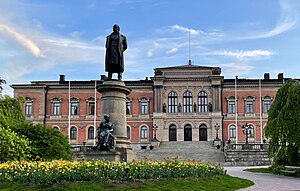
Back Universiteit van Uppsala Afrikaans جامعة أوبسالا Arabic جامعة اوبسالا ARZ Uppsala Universiteti Azerbaijani اوپسالا بیلیمیوردو AZB Упсальскі ўніверсітэт Byelorussian Упсальскі ўнівэрсытэт BE-X-OLD Упсалски университет Bulgarian উপসালা বিশ্ববিদ্যালয় Bengali/Bangla Universitat d'Uppsala Catalan
Uppsala universitet | |
 | |
| Latin: Universitas Regia Upsaliensis[1] | |
| Motto | Gratiae veritas naturae (Latin) |
|---|---|
Motto in English | Truth through the grace of God and through nature[2] |
| Type | Public research university |
| Established | 1477 |
| Budget | SEK 7.398 billion[3] |
| Rector magnificus | Anders Hagfeldt[4] |
Academic staff | 4,135 FTE[3] |
Administrative staff | 2,150 FTE[3] |
| Students | 52,241 (28,289 FTE)[3] |
| 2,228[3] | |
| Location | , |
| Campus | Urban / University town |
| Colours | Maroon, white |
| Affiliations | Coimbra Group EUA Matariki Network of Universities Guild of European Research-Intensive Universities |
| Website | uu.se (in Swedish) |

Uppsala University (UU) (Swedish: Uppsala universitet) is a public research university in Uppsala, Sweden. Founded in 1477, it is the oldest university in Sweden and the Nordic countries still in operation.[5]
Initially founded in the 15th century, the university rose to significance during the rise of Sweden as a great power at the end of the 16th century and was then given relative financial stability with a large donation from King Gustavus Adolphus in the early 17th century. Uppsala also has an important historical place in Swedish national culture, and identity for the Swedish establishment: in historiography, religion, literature, politics, and music. Many aspects of Swedish academic culture in general, such as the white student cap, originated in Uppsala. It shares some peculiarities, such as the student nation system, with Lund University and the University of Helsinki.
Uppsala belongs to the Coimbra Group of European universities and to the Guild of European Research-Intensive Universities.[6] It has ranked among the world's 100 best universities in several international rankings.[7][8][9]
The university has nine faculties distributed over three disciplinary domains: Humanities and Social Sciences, Medicine and Pharmacy, and Science and Technology. As of 2020[update], it had approximately 52,000 registered students at the undergraduate and postgraduate levels and 2,200 PhD students.[3]
Architecturally, Uppsala University has traditionally had a strong presence in Fjärdingen, the neighbourhood around the cathedral on the western side of the river Fyris. Despite some contemporary building developments further away from the centre, Uppsala's historic centre continues to be dominated by the presence of the university.[10]
- ^ Anderson, Peter John (1907). Record of the Celebration of the Quatercentenary of the University of Aberdeen: From 25th to 28th September, 1906. Aberdeen, United Kingdom: Aberdeen University Press (University of Aberdeen). ASIN B001PK7B5G. ISBN 9781363625079.
- ^ "Uppsala University – Academic symbols". Uppsala University. Retrieved 28 June 2018.
- ^ a b c d e f "Quick facts about Uppsala University". Uppsala University. Retrieved 28 July 2021.
- ^ University Management Archived 13 January 2018 at the Wayback Machine, Uppsala University, retrieved 25 January 2021
- ^ Ridder-Symoens, Hilde de. A History of the University in Europe. Cambridge University Press, 2003. p. 84.
- ^ "Members – The Guild". The Guild. Retrieved 20 April 2017.
- ^ "Uppsala University in International Rankings". Uppsala University. Retrieved 20 April 2017.
- ^ "Shanghai Ranking-Universities". shanghairanking.com. Retrieved 23 July 2021.
- ^ "University | Ranking Web of Universities: Webometrics ranks 30000 institutions". webometrics.info. Retrieved 23 July 2021.
- ^ Sten Lindroth. A History of Uppsala University: 1477–1977. Almqvist & Wiksell International (1976).